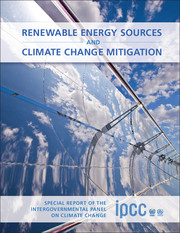 Renewable Energy Sources and Climate Change Mitigation
Renewable Energy Sources and Climate Change Mitigation Published online by Cambridge University Press: 05 December 2011
Executive Summary
Geothermal energy has the potential to provide long-term, secure base-load energy and greenhouse gas (GHG) emissions reductions. Accessible geothermal energy from the Earth's interior supplies heat for direct use and to generate electric energy. Climate change is not expected to have any major impacts on the effectiveness of geothermal energy utilization, but the widespread deployment of geothermal energy could play a meaningful role in mitigating climate change. In electricity applications, the commercialization and use of engineered (or enhanced) geothermal systems (EGS) may play a central role in establishing the size of the contribution of geothermal energy to long-term GHG emissions reductions.
The natural replenishment of heat from earth processes and modern reservoir management techniques enable the sustainable use of geothermal energy as a low-emission, renewable resource. With appropriate resource management, the tapped heat from an active reservoir is continuously restored by natural heat production, conduction and convection from surrounding hotter regions, and the extracted geothermal fluids are replenished by natural recharge and by injection of the depleted (cooled) fluids.
Global geothermal technical potential is comparable to global primary energy supply in 2008. For electricity generation, the technical potential of geothermal energy is estimated to be between 118 EJ/yr (to 3 km depth) and 1,109 EJ/yr (to 10 km depth). For direct thermal uses, the technical potential is estimated to range from 10 to 312 EJ/yr. The heat extracted to achieve these technical potentials can be fully or partially replenished over the long term by the continental terrestrial heat flow of 315 EJ/yr at an average flux of 65 mW/m2.
To save this book to your Kindle, first ensure [email protected] is added to your Approved Personal Document E-mail List under your Personal Document Settings on the Manage Your Content and Devices page of your Amazon account. Then enter the ‘name’ part of your Kindle email address below. Find out more about saving to your Kindle.
Note you can select to save to either the @free.kindle.com or @kindle.com variations. ‘@free.kindle.com’ emails are free but can only be saved to your device when it is connected to wi-fi. ‘@kindle.com’ emails can be delivered even when you are not connected to wi-fi, but note that service fees apply.
Find out more about the Kindle Personal Document Service.
To save content items to your account, please confirm that you agree to abide by our usage policies. If this is the first time you use this feature, you will be asked to authorise Cambridge Core to connect with your account. Find out more about saving content to Dropbox.
To save content items to your account, please confirm that you agree to abide by our usage policies. If this is the first time you use this feature, you will be asked to authorise Cambridge Core to connect with your account. Find out more about saving content to Google Drive.